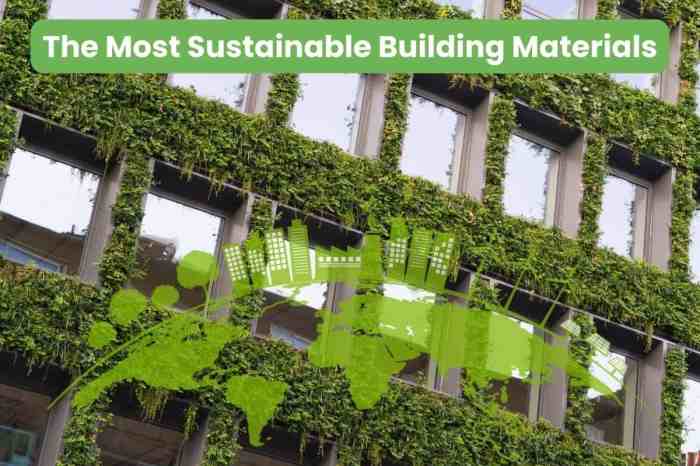Sustainable building materials are revolutionizing the construction industry, offering eco-conscious solutions that benefit both the environment and our communities.
These materials encompass a wide range of options, from bamboo and reclaimed wood to recycled steel, each contributing to a reduced carbon footprint while enhancing the durability and aesthetic appeal of buildings. As awareness grows, the significance of these materials is becoming increasingly clear, demonstrating their potential to transform both residential and commercial spaces into sustainable havens.
Sustainable Building Materials Overview
Sustainable building materials are those that are sourced, produced, and utilized in a manner that minimizes environmental impact while promoting ecological balance. The significance of these materials lies in their ability to reduce energy consumption, decrease waste, and enhance the longevity of structures. As the construction industry seeks to address climate change and resource depletion, the shift towards sustainable materials has become more crucial than ever.
Commonly used sustainable materials include bamboo, recycled steel, reclaimed wood, and natural insulation materials. Utilizing these options not only contributes to a healthier environment but also provides various benefits in both residential and commercial buildings. The advantages of incorporating sustainable materials include improved air quality, reduced utility costs, and increased property value, making them an appealing choice for builders and investors alike.
Types of Sustainable Building Materials
A wide array of sustainable building materials exists, each with unique properties and benefits. The primary types include:
- Bamboo: A highly renewable resource, bamboo grows rapidly and has a high strength-to-weight ratio, making it suitable for various applications.
- Recycled Steel: This material reduces the need for virgin raw materials and requires less energy to produce compared to new steel, significantly lowering its carbon footprint.
- Reclaimed Wood: Salvaged from old buildings, reclaimed wood not only prevents deforestation but also provides unique aesthetic qualities and durability.
- Natural Insulation Materials: Options like sheep’s wool, cellulose, and cork offer effective thermal insulation while being biodegradable and non-toxic.
| Material | Renewability | Recyclability | Energy Efficiency |
|---|---|---|---|
| Bamboo | High | No | High |
| Recycled Steel | Medium | High | Medium |
| Reclaimed Wood | Medium | Yes | Medium |
| Natural Insulation | High | No | High |
Impact on Real Estate
The use of sustainable building materials is significantly impacting the real estate market. As awareness of environmental issues grows, buyers are increasingly interested in properties that showcase green features. Real estate agents are adapting to these trends by promoting green properties, which often command higher prices due to their energy efficiency and eco-friendly benefits. Luxury homes and mansions that incorporate sustainable materials tend to have enhanced property values, as they are viewed as more desirable investments.
These homes appeal to a niche market of eco-conscious buyers willing to pay a premium for sustainability features.
Benefits for Real Estate Investors
Investing in properties built with sustainable materials offers several financial advantages. Firstly, these properties typically have lower operational costs due to increased energy efficiency, resulting in reduced utility bills. Additionally, sustainable buildings are often more attractive to potential renters or buyers, particularly in the luxury sector where environmental concerns are a priority.Several successful green real estate investment projects illustrate the profitability of this trend.
For example, developments that incorporate solar panels and energy-efficient appliances not only reduce environmental impact but also enhance the appeal of the property, leading to higher occupancy rates and rental yields.
Commercial Properties and Sustainability
Sustainable materials play a vital role in commercial construction projects. Businesses that implement eco-friendly building practices often experience long-term cost savings through reduced energy consumption and maintenance expenses. Moreover, sustainable commercial properties can attract tenants who prioritize corporate social responsibility and sustainability in their business models.A variety of certifications and standards exist for sustainable commercial properties, including LEED (Leadership in Energy and Environmental Design), BREEAM (Building Research Establishment Environmental Assessment Method), and Energy Star certification.
These certifications not only validate the sustainability efforts but also enhance the marketability of the properties.
Residential Properties and Sustainable Practices
Homeowners can incorporate sustainable materials into their residential building projects, significantly contributing to environmental conservation. This can be achieved through the use of energy-efficient windows, sustainable flooring options, and eco-friendly insulation materials. Home staging that emphasizes sustainable features can further enhance property appeal. For instance, showcasing energy-efficient appliances and natural materials can attract buyers who value eco-friendly living. Green renovations, such as installing solar panels or rainwater harvesting systems, can also positively impact residential property values, providing a return on investment in the long run.
Real Estate Marketing for Green Properties
Real estate agents can employ various strategies to effectively market properties built with sustainable materials. Highlighting energy efficiency and eco-friendly features in property listings is essential in attracting environmentally conscious buyers. Effective marketing phrases can make a significant difference in how properties are perceived. Below is a table of effective phrases to consider when marketing green real estate:
| Marketing Phrase | Target Audience |
|---|---|
| “Energy-efficient design for sustainable living” | Eco-conscious buyers |
| “Built with reclaimed materials for a unique touch” | Luxury buyers |
| “Low utility costs with green technology” | Budget-conscious buyers |
| “Invest in a sustainable future” | Long-term investors |
Challenges and Solutions in Sustainable Building

While the benefits of using sustainable materials are clear, several challenges exist in their implementation. Common issues include higher initial costs and a lack of awareness or understanding among builders and consumers. Innovative solutions can help overcome these obstacles. For instance, education and training for builders on sustainable practices can lead to greater adoption of eco-friendly materials. Additionally, financial incentives and rebates offered by governments can alleviate the cost burden associated with green building materials.
Case studies of successful sustainable building initiatives demonstrate the viability of these solutions. Projects that have embraced sustainable practices not only achieve environmental goals but also set benchmarks for future developments in the industry.
Closing Summary
In summary, the integration of sustainable building materials not only promotes environmental stewardship but also adds value to properties in today’s real estate market. By embracing these eco-friendly practices, we pave the way for a greener future, ensuring that our buildings reflect our commitment to sustainability and responsible living.
Essential Questionnaire
What are sustainable building materials?
Sustainable building materials are resources used in construction that have a minimal environmental impact and promote eco-friendly building practices.
Why are sustainable building materials important?
They reduce waste, lower carbon emissions, and create healthier living and working environments, making them crucial for combating climate change.
Can sustainable building materials save money?
Yes, they can lead to long-term savings through energy efficiency, reduced maintenance costs, and potential tax incentives for green building practices.
How do I choose sustainable materials for my project?
Consider factors such as the material’s lifecycle, sourcing practices, energy efficiency, and certifications like LEED when selecting sustainable materials.
Are sustainable buildings more expensive to construct?
While initial costs can be higher, sustainable buildings often result in significant savings over time due to energy efficiency and lower operational costs.
